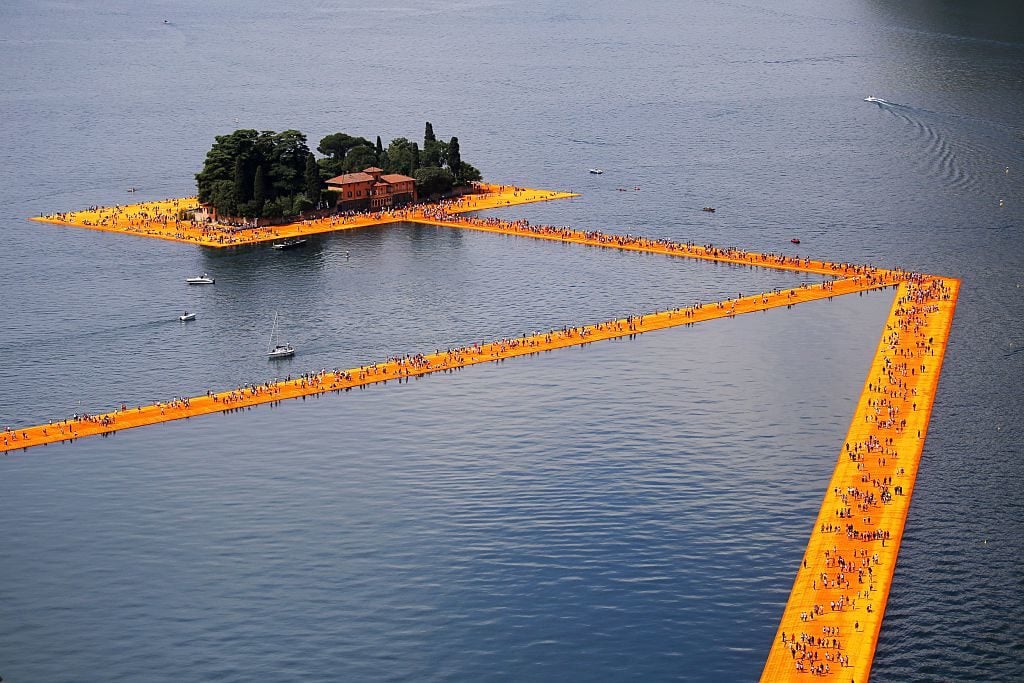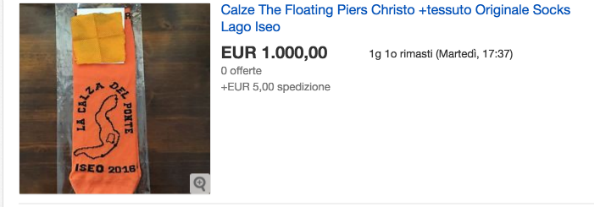Art World
Chunks of Christo’s ‘Floating Piers’ Already Flooding eBay
The clandestine souvenirs can fetch up to €1,000.

The clandestine souvenirs can fetch up to €1,000.

Naomi Rea

After three decades of careful planning and a successful 16-day run, Christo and late wife Jeanne-Claude’s ambitious “Floating Piers” installation finally closed down on July 3.
For two weeks, a Northern Italian lake was transformed by 100,000 square meters of shimmering golden fabric supported by a floating dock system of 220,000 polyethylene cubes that undulated with the waves beneath the feet of visitors who, for the first time in history, could walk from the mainland to the islands of Sulzano, Monte Isola, and San Paolo.
In a statement to the press, it was announced that the materials used for “Floating Piers”, which include the fabric, cubes and the 200 dead-weight anchors that held the piers in place are to be industrially recycled for use in a variety of applications over the next three months.
“We are grateful to all the local leaders and authorities for their partnership on this project,” said Operations Director Vladimir Yavachev. “Maintaining the Lake and its surroundings continues to be a top priority for us. We will remove all components of The Floating Piers over the course of three months, and we will leave Lake Iseo as if we were never here.”
But it looks as though some have beaten them to the clean up, as Austrian outlet Der Standard is reporting that pieces of Christo’s yellow brick road are already appearing for sale across the internet. Individual squares of the fabric are being auctioned on eBay for up to €50, and other available packages that include the official Lake Iseo socks visitors were given to walk on the fabric are being listed for up to €1000.

A section of the fabric from “Floating Piers” and Lake Iseo socks as they appear for auction on Ebay.
These clandestine souvenirs are the first relics of the massive public art installation that received 1.2 million visitors eager to emulate another famous Christo and get their own chance to walk on water.
The incredibly photogenic installation shot to viral stardom on Instagram but its unexpected popularity proved to be a challenge. As visitor numbers mounted to more than double what was anticipated, the fabric was quickly worn out, forcing the temporary closure of the site for maintenance, and prompting local authorities to insist that the installation, initially conceived to be open 24 hours a day, close at night.
Not long after, an Italian consumer group called for an investigation into the cost of the installation, taking issue with the planned support from local authorities despite the fact that Christo himself funded €18m to cover the assembly, installation, maintenance, security, and removal of the work of art.
One of the major draws of the installation was its nomadic aesthetic, but it is evident from those rushing to buy their own yellow-dahlia keepsakes, that many don’t intend it to be forgotten so soon.
“Monte Isola was ‘Caput Mundi’ [Capital of the World] for 16 days,” the Mayor of Monte Isola, Fiorello Turla, said. “I was there, I’ve been part of this incredible event that was The Floating Piers. Hotels, restaurants, bars, and shops recorded astonishing attendance, and images of Lake Iseo were broadcast on the major international networks. For my small island it’s been a challenge that we enthusiastically met and we are grateful for this wonderful experience, which will have lasting impact on the future of the tourist industry of our area.”